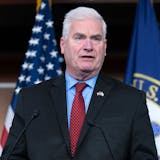Minnesota school districts are welcoming the Legislature's boost in school spending but are still sorting out how much it will help to stave off budget cuts for the coming school year.
The two-year state education budget includes $554 million in new spending, with money earmarked for budget gaps in special education, English-language services, programs aimed at diversifying the teaching ranks and, most notably, an increase to the amount of money that flows from the state to school districts for each student enrolled. The per-pupil funding formula will go up by 2.45% next year and 2% for the following school year, the largest increase in a decade and a half.
For the many public schools that faced a drop in enrollment and a surge in expenses during the pandemic, those increases were good news. But by the time the Legislature worked out the details, districts had already finalized their budgets for the 2021-22 school year, with many sending out layoff notices and telling families about program cuts and other reductions.
Now, less than two months before classes resume, school leaders are recalibrating for their new budget reality, figuring out where they can adjust — and where it's too late to avoid cuts.
"For school districts in general it's probably been one of the more challenging years to come up with a budget and feel like it's done," said DeeDee Kahring, executive director of finance and business for Wayzata Public Schools.
The increase in the per-pupil funding formula, the basis of districts' overall budgets, came as a surprise to many school administrators who had expected that pandemic-related shortfalls and political disputes might derail a school spending package.
At the State Capitol, there had been plenty of room for disagreements on both money and policies ranging from private-school vouchers to social studies curriculum standards. Lawmakers also had sharp disputes over how much the state should spend on schools next year, given the more than $2.6 billion in federal relief money that's been made available to Minnesota schools during the COVID-19 pandemic.
In the end, most of the policy items unrelated to the budget were cut from the bill, as well as some spending proposals on smaller-ticket items.

